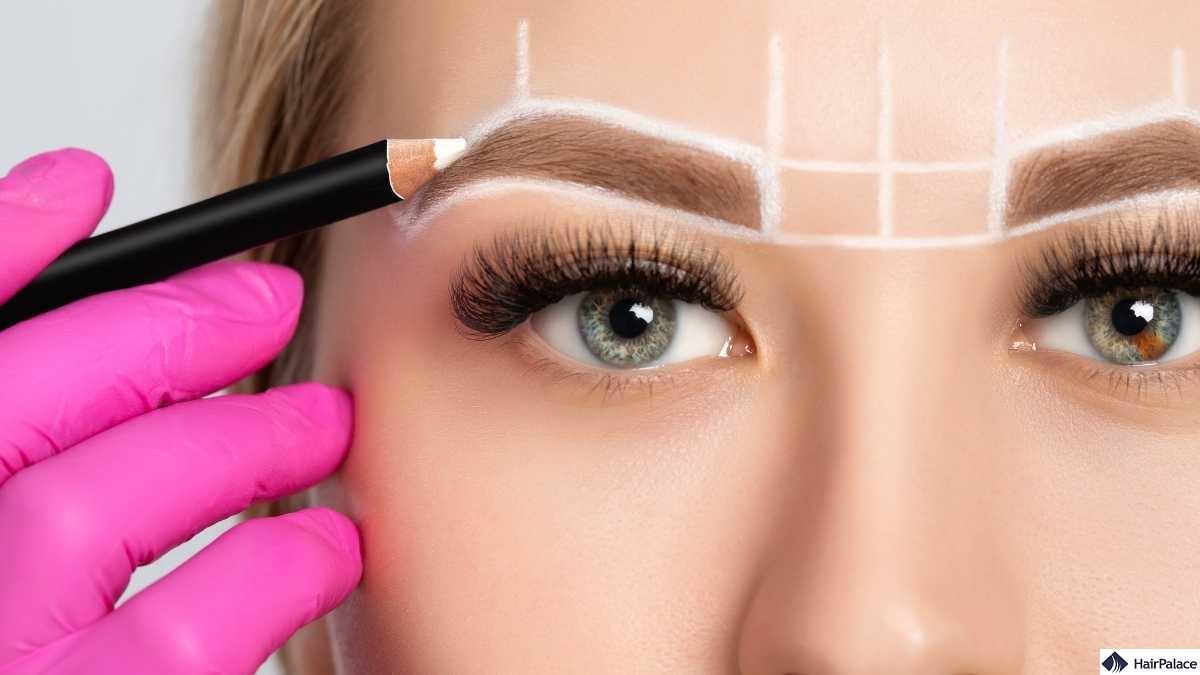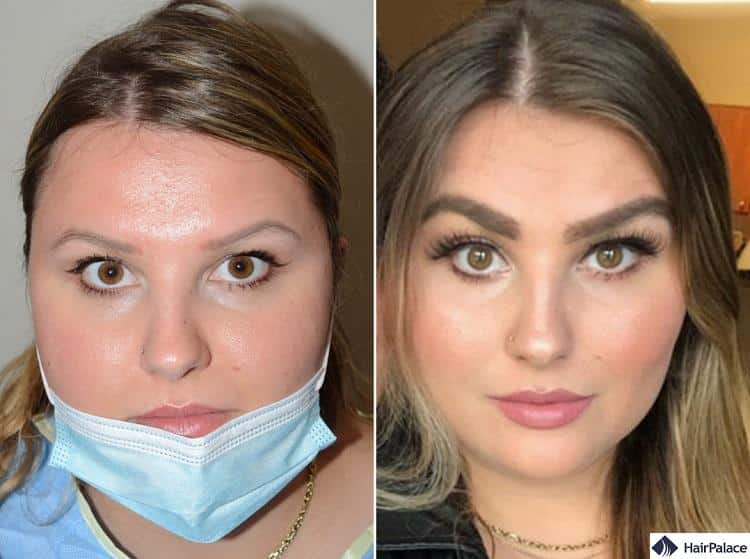Eyebrow Transplant: Procedure, Costs, and Results

An eyebrow transplant is a cosmetic procedure designed to restore or enhance the appearance of eyebrows.
It is commonly used to address thinning or patchy eyebrows due to over-plucking, genetics, trauma, or medical conditions.
Recovery typically involves minor swelling and redness, with full results visible in a few months as the transplanted hairs grow and blend with the natural brows.
Interest in the procedure has grown significantly in the past few months, mainly due to Chrissy Teigen’s admission about having undergone eyebrow transplantation.
Eyebrows have a significant influence on your face shape and can make a major difference in how you feel about your appearance.
In this article, we’ll explore eyebrow transplants and help you determine whether it’s the right choice for you.
- What is it?
- Are you a good candidate?
- Pros and Cons
- What to expect
- Before and After
- Side effects
- How much does it cost?
- Finding a surgeon
- Takeaway
What is an eyebrow transplant?
During eyebrow transplant surgery the hair is taken from a donor area and transplanted into the eyebrow area to create a fuller brow shape.
The surgeon typically uses the back or side of the head as a donor site, as these hairs are the most resistant to hair loss.
The surgery is done under a local anaesthetic and typically utilizes the same FUE (Follicular Unit Extraction) method used in hair transplantation.
With FUE the surgeon extracts hair follicles individually, which are then inserted into the brow area.
An eyebrow transplant is a much more delicate procedure than a hair transplant because the surgeon has to carefully choose the position of each incision so that they line up with the angulation of the eyebrow.
The whole procedure takes around 3 to 4 hours and causes minimal discomfort. As the surgeon only makes small incisions, the healing process is also relatively quick.
Due to the high precision involved in eyebrow transplants, only a few surgeons can carry out successful operations.
Generally speaking, eyebrow implants are extremely safe and have a high success rate of around 95%.
Although depending on the extent of your hair loss, and how many grafts you need in order to fill up each eyebrow, it might take more than one session to achieve the desired results.
Who is a good candidate for eyebrow transplants?
There are a couple of key factors that may make you a suitable candidate for an eyebrow hair transplant procedure:
1. People who purely want a cosmetic change
Most eyebrow transplants are done on people who have previously over-plucked and are now looking for wider and thicker eyebrows, or who have a naturally thin brow area.
2. People who’ve suffered from trichotillomania
Trichotillomania is a compulsive behavioural disorder where someone pulls on their own hair as a way to cope with stress.
People who have recovered from the condition often look for ways to replace their missing hair or brows, making them ideal candidates for eyebrow hair transplantation.
3. People who suffered physical trauma to the brow area
Certain injuries can result in scarring along the eyebrow area.
Additionally, certain medical treatments such as chemotherapy can also result in eyebrow hair loss.
It is important to consult with a surgeon who will help you find out if you’re suitable for an eyebrow scar hair transplant, or if you should consider other treatments such as microblading.
Pros and Cons
Pros
- As the surgeon uses your own hairs, the surgery leads to completely natural results. Most people won’t even be able to tell that you underwent the procedure.
- Having an eyebrow transplant is a permanent solution for thin eyebrows, that can restore the fullness of your brows and enhance your appearance.
- The healing process is relatively quick after an eyebrow transplant, as the procedure only causes slight bruising.
Cons
However, there are also certain downsides and possible complications that you should consider.
- Eyebrow restoration cost may be as high as £5,000.
- It may take several months or even up to a year before you see results.
- As it is a surgery, there is a risk of complications, including infection and cyst formation.
- Your new brow will require regular maintenance. Eyebrow implants use head hair, which means you will most likely need to trim your eyebrows on a weekly basis in order to maintain a natural appearance. You should also consider investing in a couple of styling tools such as brow scissors and a spoolie.
What can you expect after the surgery?
Once the new eyebrow hair is inserted, it typically takes around 4 days for it to heal.
It is important to avoid contact with water during this period as it may cause damage to the transplanted hair grafts.
You may spot some scabbing around the implanted follicles, but it’s important not to touch or pick at these as you may damage the transplanted hair.
You should also avoid physical exercise for up to 3 weeks after the procedure. Contact your clinic if you notice bleeding, swelling, or pus.
After this 4-day period, your new hair follicles will become completely embedded into the skin.
However, it is important to note that you won’t see any visible change in the first few weeks.
The new hairs will slowly begin to grow over a 6-month period. After about a year, your new brows will have reached their full potential.
Eyebrow hair transplants can restore your brows to their original fullness. However, your transplanted hairs will act differently than normal brow hairs.
Eyebrow implants use head hair, which means that your new hair will grow faster than the rest of your eyebrows.
Eyebrow transplant before and after
Here are some before and after photos to give you a better idea of how eyebrow transplants can transform your looks.

Model Chrissy Teigen had her procedure done in the spring of 2022, and based on her Instagram posts, she seems to be delighted with the results.

As you can see above, you don’t need to be a famous model to achieve the same results as Chrissy.
FUE eyebrow transplant UK procedures can change the look of almost anyone.
Eyebrow transplant side effects
The risks involved with the procedure are very similar to a hair transplant.
There is a risk that the new follicles won’t anchor into the skin properly. In these cases, the procedure has to be repeated.
The surgery may also result in:
Furthermore, while it’s generally possible to carry out both a female and male eyebrow transplant, these procedures aren’t suitable for everyone.
Your doctor may advise you against the procedure if you’re suffering from an autoimmune disease such as alopecia areata.
Having a history of trichotillomania or bleeding disorders also lowers your chance of having a successful surgery.
How much does it cost?
The exact price of your eyebrow transplant will always depend on your individual needs, the provider you choose, and your geographical location.
Generally speaking, you can expect to pay anywhere from £2,500 to £7,000. This also includes any additional fees you may encounter.
As it’s a cosmetic procedure, it is not covered by the NHS unless it is deemed necessary due to hair loss from an accident or medical condition.
While the price may appear steep, most providers offer various payment options. It is possible to find discounts, financing, and payment plans.
Where should you have this procedure done?
Eyebrow hair transplants are performed by either a dermatologic, cosmetic or plastic surgeon. It may be carried out in either an outpatient facility or a medical spa.
You should explore all of your options before committing to the surgery.
Check the credentials of your surgeon and go on Google to see the reviews of previous patients. This will give you a better idea of the level of care you can expect.
A lot of overseas clinics lure in patients with shockingly low prices.
However, you should be aware that many of these clinics employ unskilled surgeons and have poor safety standards.
Choosing such a clinic can significantly increase the chance of side effects, and you may walk away with an unsatisfactory result.
The best way to find a reputable provider is to ask your local GP to recommend a dermatologist.
Conclusion
If you consider having an eyebrow transplant (or any other surgical treatment for that matter) make sure to do proper research so you can make an informed decision.
It is important to choose a surgeon who has an excellent track record in carrying out an eyebrow transplant for men and women.
Ask to see before and after photos from previous surgeries, and have an in-depth conversation with your clinic to ensure they understand your desired outcome.
Eyebrow Transplant FAQ
Yes, this procedure involves transferring hair follicles from another part of the body to the eyebrow area to restore or enhance their appearance.
Eyebrow transplants are permanent. Once the transplanted hair follicles take root and begin to grow (usually within 3–4 months), they continue to grow like natural hair. Full results are typically visible after 9–12 months, and with proper care, they last a lifetime. However, some maintenance like trimming may be needed, since the transplanted hairs often come from scalp hair, which grows longer.
The cost of an eyebrow transplant depends on several factors, but you can generally expect to pay anywhere from £2,500 to £7,000.
Yes, you can get a hair transplant on your eyebrows. It’s a common procedure for people with thinning, over-plucked, or naturally sparse brows. The goal is to restore a fuller, natural-looking shape.
Eyebrow transplants involve taking individual hair follicles and implanting them into the brow area. Each hair is carefully placed to match the natural growth direction of eyebrow hair. The transplanted hairs grow like normal hair and may need occasional trimming.
Last medically reviewed on May 6th, 2025
- Rajput RJ. Hair Transplant for Eyebrow Restoration. Indian J Plast Surg. 2021 Dec 14;54(4):489-494. doi: 10.1055/s-0041-1739253. PMID: 34984090; PMCID: PMC8719974.https://pubmed.ncbi.nlm.nih.gov/34984090/
- Figueira E, Wasserbauer S, Wu A, Huilgol SC, Marzola M, Selva D. Eyebrow reconstruction. Orbit. 2017 Oct;36(5):273-284. doi: 10.1080/01676830.2017.1337171. Epub 2017 Jul 12. PMID: 28700281.https://pubmed.ncbi.nlm.nih.gov/28700281/
- Wolff H, Fischer TW, Blume-Peytavi U. The Diagnosis and Treatment of Hair and Scalp Diseases. Dtsch Arztebl Int. 2016 May 27;113(21):377-86. doi: 10.3238/arztebl.2016.0377. PMID: 27504707; PMCID: PMC4908932.https://pubmed.ncbi.nlm.nih.gov/27504707/
- Klingbeil KD, Fertig R. Eyebrow and Eyelash Hair Transplantation: A Systematic Review. J Clin Aesthet Dermatol. 2018 Jun;11(6):21-30. Epub 2018 Jun 1. PMID: 29942421; PMCID: PMC6011870.https://pubmed.ncbi.nlm.nih.gov/29942421/


